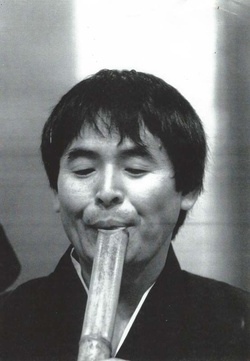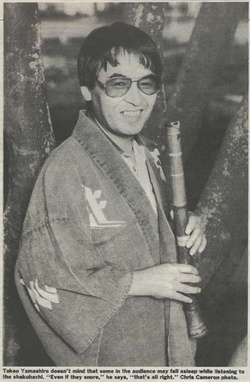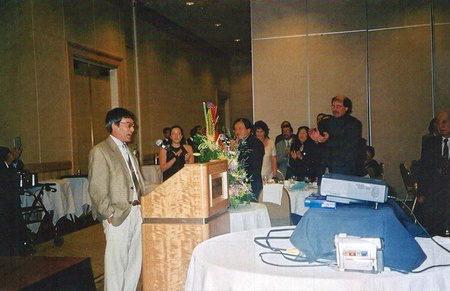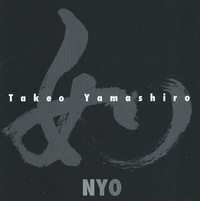While I have never met Takeo Yamashiro in person, he seems familiar to me in a way that good friends are even the first time you meet them.

Now, I had heard of Takeo even when I was living on Bowen Island in British Columbia and in the BC Kootenays in the early 1990s. He was the “Japanese flute player” (shakuhachi). That in itself was an exotic designation as the playing of traditional Japanese music was something that few non-Japanese ever pursued.
When you’re living in Japan amongst the Japanophile gaijin community which is a world unto itself, you get connected with some pretty esoteric outsiders. As I was well connected to the aikido community in Sendai, I was fortunate to meet an eccentric group that was and continue to be in Japan for a wide variety of reasons that have more to do with lifestyle choices than practical reasons that shackle most of us who returned. (A couple of Californians I knew were shakuhachi players: Eric was self taught and Michael was a student of a well known teacher in Osaka.) When I was living in Japan, I was well connected with the large international community of free spirits, neo-Beatniks, old hippies, and other truth seekers who find some peace there.
Conversely, much less known are the Japanese who seek a refuge of sorts here in Canada as for many of the same reasons.
Unbeknownst to the both of us, Takeo and I share many friends in the BC Nikkei community. Throughout our many emails, this interview developed very much into a conversation between two old friends chatting about old times.
* * * * *
Takeo: “Thank you for your interest in me and community involvement and allowing me to share my experiences. What I can say? In retrospect, is simply that the Issei in/around Tonari-Gumi gave me tremendous opportunities to learn about our Nikkei traditional values based on their daily community life.
He begins: “I was born in 1943, in Hiroshima, Japan. I was only two years old and remember nothing about what had happened to us all (in the aftermath of the atomic bomb). I grew up there through the restoration of the whole city. My university education and professional activities, however, were based in the Kyoto and Osaka area. I came to Vancouver, Canada as a tourist in June 1972, by an invitation of my musical students from Canada. I then became a landed immigrant in the following year as a ‘Musician Instrumentalist’ (for the shakuhachi).
“While performing with Japanese/non-Japanese musicians in the genres of Japanese traditional & modern, inter-ethnic, fusion, and other exploratory music, I participated fully in the community-rebuilding and its re-birth process of the Vancouver JC community throughout the birth, the growth, and its first 30 years of Tonari Gumi (located now at 42 West 8th Ave., Vancouver) as the Executive Director. I retired from the community work in 2004—the best decision in my life to remove myself while both the organization and myself were young yet and have some more miles to go!
Is there a reason why you chose to immigrate to Canada?
In answering to your question as to why I chose Canada, I don’t really have a straight answer, I was probably ready to jump off the ship—after my personal conclusion that the scientific development and computerization are changing our life and culture and would eventually make all the people identical in that even their process of encounter, feeling, thinking, etc. would all be programmed and fully operated based on a designed manual.
I eventually reached a personal conclusion back then based on my personal experiences growing up in Japan. My frustrations led to tremendous stress. This all built up inside me to the point where I feared becoming even further alienated from who I really am to the point where I was ready to explode. I was very much looking for an opportunity to seek an alternative lifestyle in a totally different cultural environment to be free of all those pressures.
Anyhow, I am not a type of person who plan or try to control your life. A go-with-the-flow kind of guy! I’d rather try to read the rhythm in motion/transition and rely on it, off or on. Thus, my life had been a full of frustrations and stress in the rigid traditional and conventional society. So, I was ready to get on a rhythm and it happened to be Vancouver to land by invitation of my students. My first three nights were spent under a big tree in Stanley Park, after discovering my students were out of town. But no big deal!
I flew in with one-way ticket and just about $150 in Japanese currency. And started hitch-hiking right from the airport and was picked up by one of the flight attendants and driven into town.
Why did you choose to settle in the Vancouver area?
The Vancouver climate and surrounding coastal terrain resembles the one where I grew up (Setouchi coastline and mountains behind the delta city of Hiroshima). I am very much convinced that only this particular district in Canada allows us get by without a bitter and cold winter.
Interesting that we share a Bowen Island connection!
Bowen Island is one of the islands I was taken within the month since my arrival. I was taken by the original owner and the founder of the Vancouver’s “Classical Joint,” where I started sharing the stage with local jazz, blues, folk, and bluegrass musicians. Salt Spring Island was another one of the first places I visited and there I met the parents of the Murakami family who were the special guests at my concert.
Can you please give us a chronology of your work experience here?
I first started “official” shakuhachi lessons in 1964. From 1968 to 1971, I worked as a Chief Systems Engineer at a subsidiary of Osaka-based Mitsubishi. From 1967 to 1973 I worked, taught, and performed with/under Kofu Kikusui as his Chief-Protégé and successor and worked at Tonari-Gumi in Vancouver from 1974 to 2004. From 1974, my musical activities have been managed by Diane Kadota Arts Management.
You and the late Jun Hamada were the co-founders of “Tonari Gumi” in Vancouver which continues to offer important assistance to Japanese Canadian seniors there. What prompted you two to start it back in 1974?

In the fall of 1973, Jun (Samuel) Hamada received a federal employment creation grant under project named “Japanese Community Volunteers”. This initial five-month-trial operation of the Issei support program, run between January and May in 1974, came into the hands of Jun and me, as one of the four original employees. The Japanese name “Tonari-Gumi” was born before the termination of the project.
The initial five months gave us a time for quick on-site need study in the Issei community. In June, Jun and I visited Downtown Eastside Residents Association (DERA) and negotiated with Bruce Eriksen to secure a office space. Bruce sympathized with our Issei’s situations in the old “Nihonmachi” area and decided to let us use a small room shared with their Chinese Community Worker. By the end of same month, June 1974, the DERA hired me as their Japanese Community Worker. Jun meanwhile had to make trips back and forth to the Vancouver General Hospital for dialysis—kidney failure.
The DERA allowed us maintain our volunteer functions through their base, and let us organize ourselves to build our own drop-in centre in one year, summer of 1975. I was on DERA’s payroll ’til March, 1976. In this sense, Tonari-Gumi is an offshoot of the DERA, too! (Jun’s younger brother, Gen, who I mention from time to time in my writings, lives in Osaka.)
Tamio Wakayama may have been the first younger JC to become part of us, and Naomi Shikaze was the first Sansei to visit the drop-in centre in 1975. There was Vancouver JCCA as the only community representative organization back then and used to running annual Keiro-kai (Seniors Celebration Day) but nothing else. And were there some other religious groups. The JCCA had never taken the leadership nor had they organized any major commemorative projects or events, when it comes to the 1977 JC Centennial Celebrations. Therefore, Tonari-Gumi became the centre of the activities, where the immigrants as the original volunteer members, young JC Nisei and Sansei came together and planned and implemented the Vancouver’s major centennial projects and events under the federal employment creation grant “B.C. Centennial Arts Workshop.”
The project was sponsored by Takeo Yamashiro and his core staff were Rick Shiomi (coordinator), Noriko Hirota (Artistic Director), etc. One of the centennial projects based in the TG community yard was the pictorial history display and booklet of “A Dream of Riches.” This group, in my personal view, later became instrumental for the Redress movement in our Vancouver community. Starting early in 1980s, they started organizing a series of community meetings and workshops on the subject of redress. The B.C. Redress Coalition, started up outside of the JCCA, were combination of strong Nisei and vocal Sansei members and met regularly at Tonari-Gumi and eventually took over the JCCA to move ahead with the rest of the JC communities.
As I earlier said, I hardly go there anymore since my retirement 10-plus years ago. I am positive to say that they are serving renewed community needs today and receive much support from the community.
How did you come to play the shakuhachi then?
My grandfather used to play but really for fun. I picked it up partly because I did not fit in the university campus environment and got tired of playing mah-jong day-in-day-out. I was able to get to know one of the best instrument makers in Japan as my shakuhachi provider all these years.
After the retirement from the Tonari-Gumi community work, the shakuhachi has become the most important daily routine indulgence. I have one Canada Council CD-making project pending or overdue. It’s been about two years since the approval and I kept postponing for one reason or another. The last project with them was almost 15 years ago and produced as NYO, of which I don’t have any more copy available. When it comes to teaching, I only have four serious students now. Several more come in from out of town once in a while. I am playing some old traditional pieces every night.
How did you become involved in Linda Ohama’s documentary about the 3-11 Tohoku Earthquake and Tsunami (which is still in production)?
My fate with Linda goes back a long way, to 1973 or 1974, when I was invited to join up with a Japan’s Shigin (poetry singing) master to perform in Lethbridge, southern Alberta. I met her grandmother as a member of local participants. She was from Hiroshima and talked to me nostalgically. Then, she sent me a couple cushions she herself sewed for me.
Years later, I was taken by one of my close artist friends, Roy Kiyooka, to Linda’s exhibit. There, I saw some photos of her grandma glued on to a canvas—my memory is vague and difficult to categorize. Anyway, I declared, “I know this woman from Lethbridge!” Since then, as far as I am concerned, we have been close and good friends.
What was the training like to become a shakuhachi player?
If I may distinguish myself from others in my time, it’s the way how I was trained and became a pro musician. It was not a popular approach but the narrow gates were open for some eager and promising musicians back then that I took advantage of.
It was a very unique traditional system setup for the purpose of inheriting one master’s art form to his disciple from generation to generation. I am probably one of the late products of this institution. Today, you hardly see musicians of my type of discipline any more. You have to be lucky enough to be appointed to such positions to begin with. I literally lived with my school-head and the founder of the school for about two years; after one-and-a-half years of my live-out discipline period was completed. It was like 24/7—you never sleep before your master and never get up later than him, period.
© 2014 Norm Ibuki








